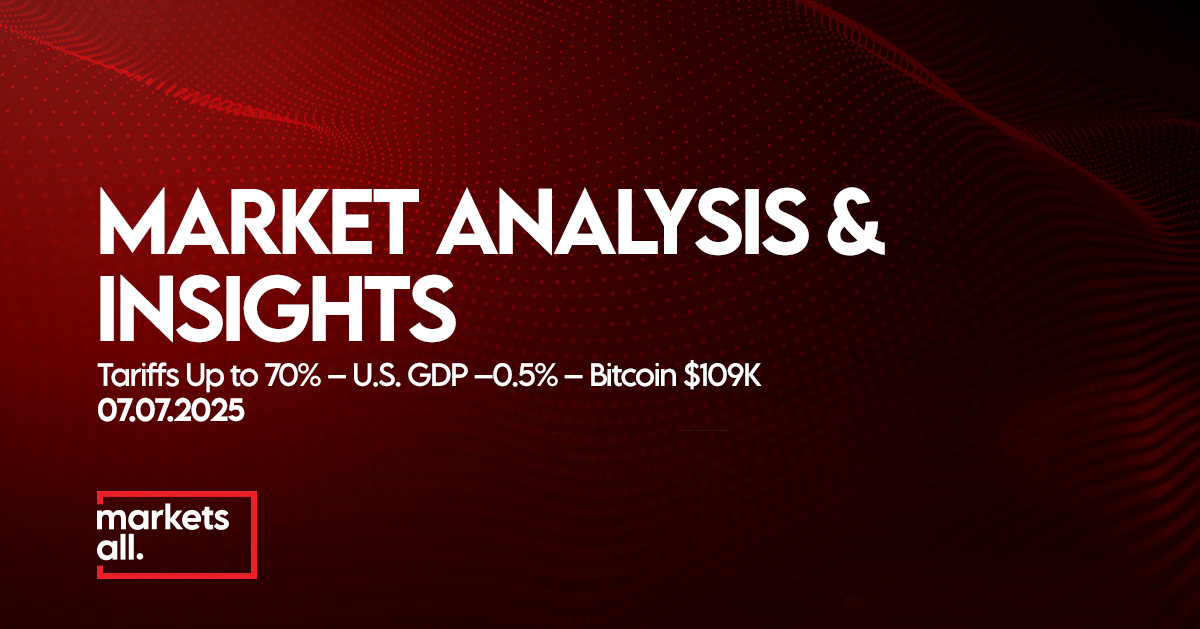This global trade and market update highlights today’s major developments, including delayed U.S. tariffs, trade deals with key partners, diverging macro data, and mixed commodity performance as investors reassess risk.
Global Trade and Market Update: United States
Markets & FX
- U.S. futures slipped slightly, reacting to shifting tariff timelines. The dollar hovered near multi-year lows as traders awaited clarity on trade policy.
Tariff Developments
- President Trump announced that higher tariffs—ranging from a 10% baseline up to 70%—will take effect on August 1, providing countries a 3-week extension from the previous July 9 deadline.
- Official letters outlining specific tariff rates or announcing interim deals are being sent starting July 7, with public disclosures expected by noon Eastern.
- Initial direct deals have been struck with the U.K. and Vietnam, while China reached a temporary truce. Other partners—Canada, EU, India, Thailand, Japan, and South Korea—are reportedly in advanced talks.
- Countries affiliated with the BRICS bloc, including China and Russia, are expected to face an additional 10% tariff on top of the baseline.
Macro Data
- Q1 GDP was revised down to –0.5% annualized (from –0.2%), reflecting weaker consumer spending and a sharp rise in imports ahead of expected tariff hikes.
Global Trade and Market Update: Europe & United Kingdom
Markets & Sentiment
- Euro-zone investor morale rose to a three-year high, underpinned by optimism over industrial output and trade deal progress.
- EU officials are negotiating for a 10% universal tariff rate while seeking exemptions for key sectors like autos, agriculture, semiconductors, and aviation.
China & Japan Economic Developments
-
China
Chinese equities closed lower, with the CSI 300 down ~0.5%. The PBOC communicated with commercial banks following continued dollar weakness, likely to ensure currency stability. President Xi moved to delegate economic decision-making authority to top deputies, a shift that may enhance responsiveness to market and policy challenges.
Japan
Real wages fell 2.9% y/y in May, marking the steepest decline in nearly two years as inflation pressures continue. However, household spending surged: May data showed +4.6% m/m and +4.7% y/y growth, the strongest in three years. The Bank of Japan’s Tankan survey reflected stable business sentiment, but tariff-related risks remain a concern ahead of the July 30–31 monetary policy meeting.
EMEA and Emerging Markets Snapshot
- Canada is weighing subsidies for domestic aluminum producers to offset potential 50% U.S. tariffs.
- India and Thailand are close to sealing deals with the U.S. India is offering tariff reductions on auto parts, steel, and farm goods; Thailand proposed zero tariffs alongside increased U.S. imports.
- Japan is pushing for sector-specific exemptions, especially for autos and rice, and considering broader trade diversification.
Commodities and Crypto Overview
- Gold declined slightly as the dollar firmed, though underlying demand remains strong amid geopolitical uncertainty.
- Oil prices steadied after OPEC+ confirmed a supply increase of 548,000 bpd for August, partially offset by tight inventories.
- Copper and other industrial metals fell on concerns over slower trade.
- Bitcoin remained near $109,000; crypto markets are stable as investors await clarity on global trade policy.
Key Takeaways and Market Themes
- Tariffs postponed: The U.S. pushed back tariff implementation to August 1, using the interim period to secure bilateral deals.
- Deals advancing: The U.K. and Vietnam have signed deals; the EU, India, Canada, Japan, and others are close to finalizing terms.
- Macro divergence: The U.S. shows softer GDP data, while Japan posts strong household spending despite falling wages.
- Commodities mixed: Oil steady amid OPEC+ output boost; gold and copper under mild pressure.
- Markets cautious: Global equities modestly lower; risk-off mood dominates as tariff timelines shift again.





Leave A Comment